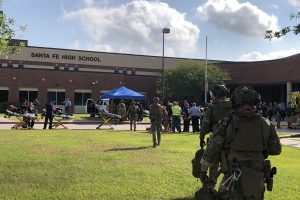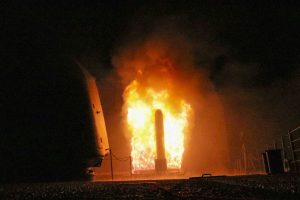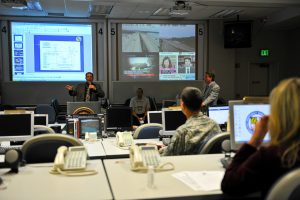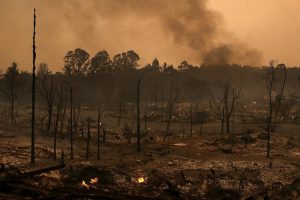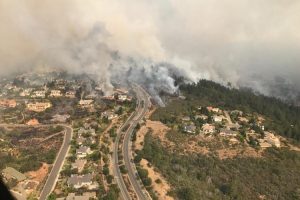On July 1, The New York Times published an article about Special Presidential Envoy for the Global Coalition to Defeat ISIS Brett McGurk’s visit to Syria.
McGurk and a small press team visited Tabqa on June 29.
#SYRIA: Today, White House special envoy to @CJTFOIR Brett McGurk & @ruperttjones met with Tabqa Civilian Council – via @AFP pic.twitter.com/TCwkwAcuYo
— Maya Gebeily (@GebeilyM) June 29, 2017
In a report on the visit, the Times claimed that the UN “has yet to begin any relief efforts in Tabqa” which “leaves the United States to serve as a stopgap for the most immediate needs” and suggested that the US said Tabqa council should contact UNICEF “when the United Nations finally reaches the town.”
The US humanitarian aid programme was announced on June 22.
Grasswire has been in contact with UNICEF and UNHCR, the UN refugee agency, about the humanitarian situation in the Tabqa area since late March. We’ve also been in touch with United Nations Office for the Coordination of Humanitarian Affairs (OCHA).
We think these claims need a closer look.
The claims
“The United Nations is active in Syria but has yet to begin any relief efforts in Tabqa, and it has mounted only one effort outside of the areas squarely controlled by the Assad government.
That leaves the United States to serve as a stopgap for the most immediate needs. Nearly 50 tons of flour, paid for by the Pentagon, were trucked in from Iraq to an American-funded warehouse on Wednesday. Another large shipment of American food aid — enough for 30,000 people for 30 days — will be divided among several towns and camps for displaced people in the Raqqa area, including Tabqa…
The Americans said that they were ready to provide desks and chalkboards, but that the Tabqa council should direct requests to the United Nations International Children’s Fund, when the United Nations finally reaches the town.
What has been the UN response?
Linda Tom, spokesperson for the OCHA in Syria, told Grasswire that UN agencies including the World Food Programme and UNHCR have been delivering food and emergency items to people in need in Tabqa, distributed through partners on the ground.
Scott Craig, Syria spokesperson for UNHCR, the UN refugee agency, told Grasswire that aid distribution has taken place in Tabqa via humanitarian partner organisations.
“UNHCR has greater access to deliver relief at Ein issa and Mabrouka camps, as well as IDP settlements in Karama, but through partners non-food items have been distributed in Tabqa – things like blankets, jerry cans, plastic sheeting, kitchen items and hygiene kits,” Craig said.

On June 13, a spokesperson for UNICEF told Grasswire that: “UNICEF’s water, sanitation and hygiene programme in Taqba, Ar-Raqqa, and across Syria focuses on providing safe drinking water and sanitation to families and children affected by the conflict.”
“UNICEF has also been providing water disinfectant for water facilities in Ar-Raqqa, including in Taqba, that ensured supply of safe drinking water,” the spokesperson said.
However, UNICEF’s efforts in Tabqa are not limited to aid for affected individuals. The agency organised repairs to Tabqa water station, and on June 13 the station was operating partially.
“Following an initial assessment completed by the local water board in Raqqa, UNICEF has mobilized resources to undertake electromechanical repairs of the water facility. Standby generator sets will also be provided to continue operation during power outages,” the spokesperson said.
“Due to insecurity, technicians are unable to access the area to repair the damage. UNICEF and partners stand ready to start the repair work, once safe access is secured,” they added.
https://www.grasswirenews.com/2017/03/syria-sdf-pauses-tabqa-dam-assault-after-coalition-says-structure-not-in-imminent-danger/
Getting aid to Tabqa
The US is able to take advantage of its position in Iraq to ship aid. As the Times notes, “Nearly 50 tons of flour, paid for by the Pentagon, were trucked in from Iraq to an American-funded warehouse on Wednesday.”
But how does the UN get aid into Raqqa?
Scott Craig from UNHCR explained the recent situation regarding transportation of aid in Syria. “Until very recently, the only way to move humanitarian assistance into Raqqa governorate was by airlift from Damascus to Qamishli [in the far northeast of the country] and then by road. This placed a number of constraints on the ability of humanitarian agencies to move supplies into the area, given that cross-border aid deliveries from Turkey are not possible,” Craig said.
“As of a few days ago, the road from Aleppo to Qamishli is now open again for aid. We ran a test convoy along it last week. This should help to give us greater reach rather than having to take everything up by air,” Craig said.
“There are of course also the usual safety issues in a recent combat zone – with unexploded mines and other ordnance still being cleared,” he added.
The new road access is making a huge difference to the UN’s response, OCHA’s Linda Tom told Grasswire, adding that WFP has been providing food assistance to Tabqa, and now plans to scale up its operation to provide assistance to 25,000 people in need on a monthly basis.

OCHA reports
OCHA reports on the humanitarian situation in Raqqa governorate regularly.
June 19 – 26
In its tenth report, covering approximately the period between June 19 and 26, OCHA said that 105,550 people were reached with food assistance near Raqqa in a seven-day period, and an estimated 48,500 people were in receipt of Water and Sanitation Hygiene (WASH) services.
More specifically, in Ath-Thawrah sub-district, which includes Tabqa city, 364 General Food Rations were distributed. Each of these packages covers the food needs of a family of six for 10 days, meaning that 2,184 people benefitted from food aid for a ten-day period.
UNHCR’s partners distributed 540 NFI Kits, 641 NFI Kits, 2,660 hygiene kits and 1,560 jerry can kits in Tabqa, Juniyeh, Mahmoudli and Twayhina.
Craig explained that “the contents of Non-food Item (NFI) Kits can vary depending on people’s needs and the availability of goods, but they generally include items such as: plastic sheets; sleeping blankets or sheets depending on season; sleeping mats; hygiene items; kerosene or gas cooker/stove; kitchen set (pots, utensils, cooking items); solar lantern; and water jerry can.”
June 8 – 19
In its ninth report, covering approximately the period between June 8 and 19, OCHA said that 951 Food Rations were distributed in Tabqa city, meaning that 5,706 people benefitted from food aid for a ten-day period.
June 1 – 10
In its eighth report, covering approximately the period between June 8 and 19, OCHA said that one cross-border INGO distributed 340 food rations in Taqba city, meaning that the food needs of around 2,040 people were covered for ten days.
340 hygiene kits and 40 NFI kits were also distributed in Tabqa neighbourhoods and schools, 360 hygiene kits were distributed in nearby Twaihinia Camp, and a further 150 hygiene kits in Mahmoudli.
May
OCHA’s seventh report covered the month of May.
In Tabqa/Ath-Thawrah sub-district, 1,197 Food Rations were distributed, meaning that the food needs of 7,200 people were covered for ten days. Additionally, 3,000 Ready-To-Eat Rations were distributed. These cover the food needs for a family of six for 5 days, which means that 18,000 people benefitted.
An INGO distributed 1,200 ready-to-eat food rations on May 31, covering food needs for a household of five for six days in Al-Iskandariyeh, near Tabqa. By June 2, most IDPs in Iskandariyah had either moved on to other locations or returned
to their areas of origin. The remaining IDPs were transferred to a new site in At-Tuwayhinah, some 27 km from Tabqa.
A World Health Organisation team conducted an assessment of health facilities in Tabqa city. WHO reported that the hospital building was partially damaged and all major medical equipment was looted, including CT-Scan, incubators, and dialysis machines. However, operation theaters were intact and hospital beds were available. There were six doctors in Tabqa city, including three pediatricians, one internal specialist, one general doctor, and one dentist. Three pharmacies are open occasionally.
Family hygiene kits were also distributed in Tabqa city and Al-Hisha village by INGOs. An INGO distributed Aquatabs and provide chlorination system for the main water treatment station in Tabqa.
More reports about the UN response in Tabqa can be found on ReliefWeb.

Conclusion
Given all the above, the assertion that the UN “has yet to begin any relief efforts in Tabqa” leaving “the United States to serve as a stopgap for the most immediate needs” is incorrect.
The suggestion that Tabqa council should contact UNICEF “when the United Nations finally reaches the town” verges on the absurd.
Postscript
The US delivered 50 tons of flour. This is approximately 45.35924 metric tonnes. Estimating that a loaf of bread uses approximately 550 grams of flour, the 50 tons supplied by the US will make roughly 82,470 loaves of bread.
Ignoring earlier deliveries – according to OCHA’s most recent report, in one week the UN delivered to Ath-Thawrah sub-district 364 General Food Rations which cover the food needs of a family of six for ten days, or 21,840 people for a single day.
In the wider Raqqa area, 105,550 people were reached with food assistance in the same seven-day period


